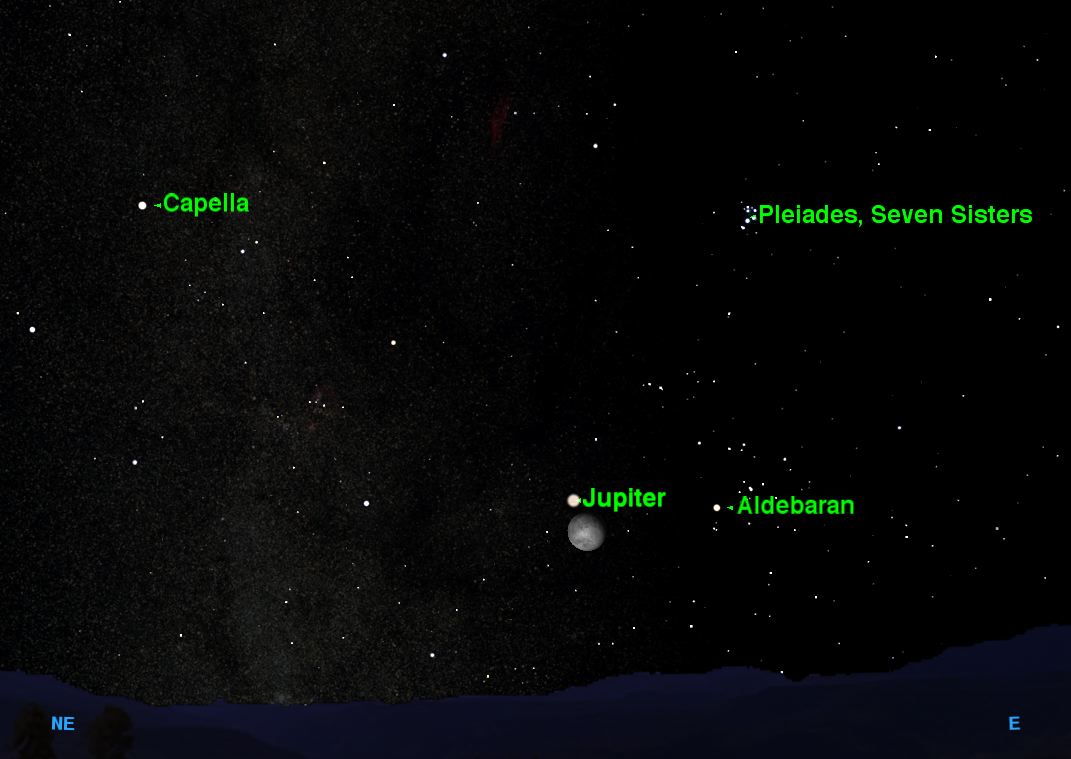Moon and Jupiter Create Celestial Halloween Treat

Look in the eastern sky for the next few nights and you will see a celestial treat.
Full moon was on Monday night (Oct. 29), so the waning gibbous moon will be rising a few hours past sunset. Jupiter, a month away from opposition on Dec. 2, will also be rising a few hours past sunset. The result will be what astronomers call a conjunction: a close encounter between two astronomical bodies.
The moon will be closest to Jupiter on Thursday night (Nov.1), but the two will also be close on Wednesday and Friday nights (Oct. 31 and Nov. 2).
The location of the moon relative to Jupiter will depend on your exact location because of something called parallax. [October 2012 Night Sky Observing Guide (Sky Maps)]
Hold a finger up at arm's length and look at a distant object. If you blink one eye and then the other, your finger will appear to jump from left to right. That's parallax, and it's what lets us view the world in three dimensions. Our two eyes are a couple of inches apart and each sees the world from a slightly different vantage. Our brains seemlessly integrate these two views into one three-dimensional picture, but if you close one eye at a time you can sense their different perspectives.
The same thing happens when people observe the moon against the starry backdrop from different spots on Earth: These slightly different perspectives create differing views.
In addition, the moon is revolving in its orbit around the Earth, causing it to appear to move from right to left against the background stars, including the planet Jupiter. Jupiter is moving too, but much more slowly than the moon, so its motion is not as obvious.
Get the Space.com Newsletter
Breaking space news, the latest updates on rocket launches, skywatching events and more!
On Wednesday night, the moon will be well to the right of Jupiter, about halfway between two of the brightest and nearest star clusters, known by their ancient Greek names: the Pleiades and the Hyades.
To the unaided eye, the Pleiades looks like a tiny "dipper," except with only six stars instead of seven. It is located 410 light-years away, and contains hundreds of stars visible in binoculars or a small telescope.
The Hyades is closer to us, only 150 light-years distant, causing its stars to appear spread over a wider area of our sky.
On Thursday night, the moon will have moved to less than a degree away from Jupiter, so close that the two will fit together in the field of a telescope. For skywatchers in South Africa the moon will actually pass right in front of Jupiter, hiding it from view for over an hour in some locations, such as Cape Town.
By Friday night, the moon will be well to the left of Jupiter, not rising until around 9 p.m. local time.
Halloween is an excellent opportunity to do some "sidewalk astronomy." It's the one night in the year when there are lots of people out and about in a friendly family atmosphere.
If it's clear, set up your telescope and "share the view" with the trick-or-treaters. Impromptu Halloween star parties have become a tradition in some neighborhoods.
This article was provided to SPACE.com by Starry Night Education, the leader in space science curriculum solutions. Follow Starry Night on Twitter @StarryNightEdu.
Join our Space Forums to keep talking space on the latest missions, night sky and more! And if you have a news tip, correction or comment, let us know at: community@space.com.

Geoff Gaherty was Space.com's Night Sky columnist and in partnership with Starry Night software and a dedicated amateur astronomer who sought to share the wonders of the night sky with the world. Based in Canada, Geoff studied mathematics and physics at McGill University and earned a Ph.D. in anthropology from the University of Toronto, all while pursuing a passion for the night sky and serving as an astronomy communicator. He credited a partial solar eclipse observed in 1946 (at age 5) and his 1957 sighting of the Comet Arend-Roland as a teenager for sparking his interest in amateur astronomy. In 2008, Geoff won the Chant Medal from the Royal Astronomical Society of Canada, an award given to a Canadian amateur astronomer in recognition of their lifetime achievements. Sadly, Geoff passed away July 7, 2016 due to complications from a kidney transplant, but his legacy continues at Starry Night.










